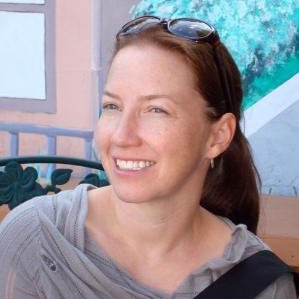Bringing Creative Science to Healthcare, An interview with DesignMap Partner Audrey Crane
 Garrett StephensAudrey Crane is one of those people who teeter softly on the balance point between the right brain and left brain. Not exclusively a creative, not exclusively a technicalist. One of those people with a healthy splash of both, which play nicely together to facilitate good design work. She’s brought this balance along with her to DesignMap, where she’s now been Partner since the summer of 2010.
Garrett StephensAudrey Crane is one of those people who teeter softly on the balance point between the right brain and left brain. Not exclusively a creative, not exclusively a technicalist. One of those people with a healthy splash of both, which play nicely together to facilitate good design work. She’s brought this balance along with her to DesignMap, where she’s now been Partner since the summer of 2010.
DesignMap provides high pedigree UX services to major clients, which have recently included Docker, EBay, HP, Aetna, Salesforce, Bloomberg, and others. For Health Technology Forum’s Common Good Innovation Conference at Stanford this May, DesignMap is sponsoring a workshop called the Healthy Aging Challenge. The idea of the challenge is to give participants the opportunity to work with design teams to come up with a creative design for how to improve access to affordable care for the elderly.
Audrey has made a name for herself in the Design/UX world by combining the artistic side of design with the open-minded objectiveness of a scientist, looking to find a data-driven successful design and then iterating that approach for further success. I had the chance to talk with Audrey and get a glimpse from the inside on DesignMap’s move to navigate their creative science approach to change the healthcare realm for the better.
 Audrey CraneQ: Tell us a little bit about your background. What led to you making the jump from design freelancing to leadership, helping to build a successful design company?
Audrey CraneQ: Tell us a little bit about your background. What led to you making the jump from design freelancing to leadership, helping to build a successful design company?
Audrey: I studied math and theatre in college, in the early 90's…I was internal in companies doing production work and was very lucky to end up at Netscape, and I had a director there [Hugh Dubberly] who had the most extraordinary mind in understanding the tricky problems. He introduced design to me in a way that was very interesting. I’ve always enjoyed the right brain/left brain balance and kind of figuring out the pragmatism. I went to work for Hugh when he started his own company. Then went to freelance, then jumped into partnership at DesignMap. With a lot of experience, you begin to learn the leadership skills that will make you effective. Leadership is a very important skill in this process.
Q: One of the articles on your site talks about what you did at the Mind the Product conference. For those who don’t know, they placed a whiteboard up at the conference with an open question: What worries you about hiring a designer? They invited attendees to place sticky notes with their worries on the board. My question is: what worries did you find popped up most in this experiment? Why do you think this was?
Audrey: We were thinking that people would answer at a systems level: “Well, I don’t know what is the right time to bring them in… how do I get budget, internally or externally?” There ended up being so many people answering “perfectionism”. That was not the answer I expected, but it was exciting to see the answer pop up from the experiment. With designers it really comes down to pragmatism and understanding your product within the larger context. This opened a broader question for us to understand: how do product managers and designers work together to produce a product? The issues that arise from going from an idea to everyone being on the same team with factoring in whatever the pragmatics are is a point that designers should take into account.
Q: I realize I’m opening (unfairly) a pseudo-Pandora’s-Box with this question, but why is design important in Health-related Software?
Audrey: The people who use these products literally die, which is a sad UX result in healthcare. But in healthcare why does it [design] suck so hard?
It used to be really bad because the people who bought it had to use it. It isn’t that way anymore, but why is this now the case? In the olden days, software was installed, but now you can click to use. the EHRs, which are the underlying run-everything in healthcare, those companies think it still works in the way that other B2B companies thought it worked 10–15 years ago, and there’s no compelling reason for them to change.
There has to be something to cause the change beyond the instant gratification of money. Not so instant as a new sale. You see startups popping up around this new presentation style, so [as an existing healthcare company] even though you’re not going to switch, you can still facilitate a better quality of life for patients and for healthcare providers.
Also, the active sales people have their sales off-site and come back with feedback, so the people giving this feedback are not actually the people using the product. They are the people selling the product. From our end, rather than just saying design is really important, because that’s not an effective argument, there needs to be an understanding that we need to communicate with users to understand how to create effective products.
Q: To cap this off: what are you looking forward to from the Healthy Aging Challenge at this year’s Common Good Innovation Conference? What are you excited about seeing come from this format?
Audrey: I have never seen anyone do this exactly, but our goals were: [1] give the people participating an option to work with a design team and a design process, with our designers on the team and in the workshop. Lots of people haven’t worked with designers! Also, [2] use things out of the Google Ventures playbook, like dot voting, crazy eights and some of the techniques there could be really helpful. We don’t know exactly how this is going to go, but my team sees me as ambitious in doing this. We need to take this a bit like the high wire act; you don’t know what’s going to happen, but we will test and iterate as we do best. Hoping that the techniques from GV will help with little insights about quick and effective decision making.
We will try to avoid what goes wrong with a lot of these: focusing way more on an exercise in group dynamic rather than focusing on what you’re actually supposed to be learning about. We will spare the time spent figuring out who will be in charge. Part of what’s going to be very interesting is how 4 teams tackle the same problem and seeing what they produce.
...
Audrey and her DesignMap team will lead the Healthy Aging Design Challenge workshop this May, as a speaker at HTFIC17. We look forward to seeing our health technology audience and challenge participants put their design skills to work in order to improve healthcare.
There is no right brain vs. left brain, usable vs. technically sound distinction that has to be made in the world of software. The idea is: let’s help the health technology industry warm up to this truth a bit so that we can begin to improve experiences for actual users throughout the entire field: sellers, doctors and patients.
If you’re interested in keeping up with innovations and trends in precision medicine and health technology, be sure to visit Health Technology Forum on the web. Speakers for the Stanford Conference this year include many leaders throughout the precision medicine field and the panels will dive into effective, cutting edge ways to really put a dent in health issues, both in our current state and in looking towards the future.
Website: Health Technology Forum - Common Good Conference Page
Also be sure to follow HTF on social media for more updates, articles and contest opportunities to win tickets to this year’s Common Good Conference.
Twitter: twitter.com/HealthTechForum
Facebook: facebook.com/HealthTechnologyForum/
| Bringing Creative Science to Healthcare, An interview with DesignMap Partner Audrey Crane was written by Garrett Stephens. It was originally published on LinkedIn.com and reprinted in Open Health News with permission from the author. The original copy of the article can be found here. |
- Login to post comments